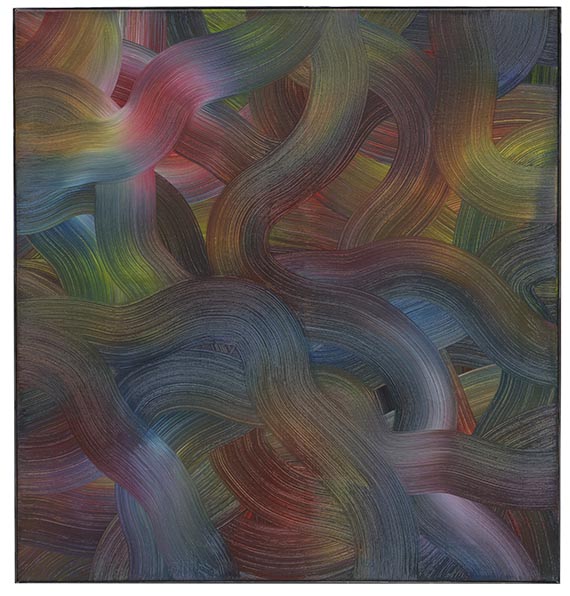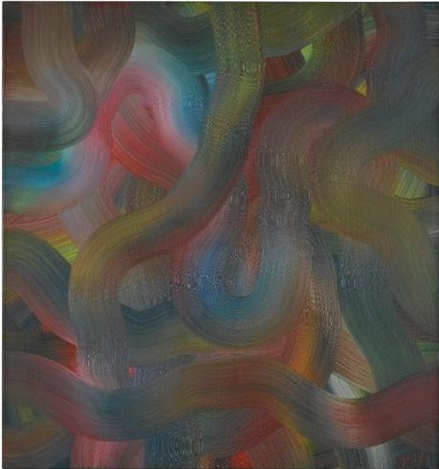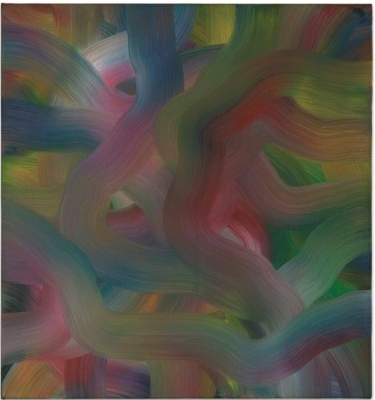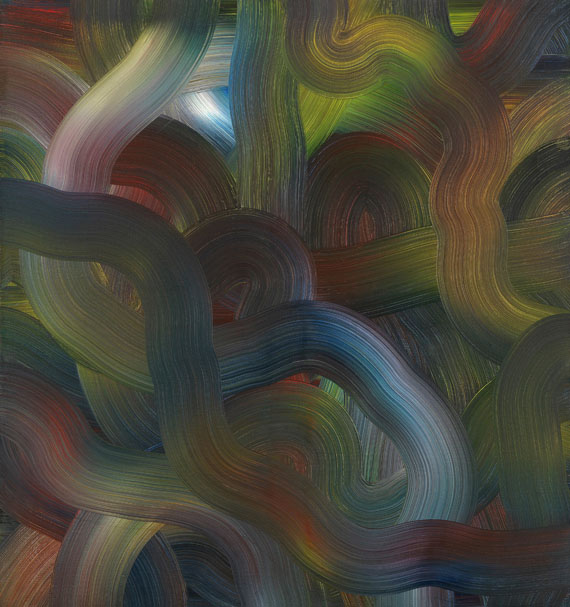Sale: 550 / Evening Sale, June 07. 2024 in Munich  Lot 124000059
Lot 124000059
 Lot 124000059
Lot 124000059
124000059
Gerhard Richter
Rot-Blau-Gelb, 1973.
Oil on canvas
Estimate:
€ 350,000 - 450,000
$ 374,500 - 481,500
Information on buyer's premium, taxation and resale right compensation will be available four weeks before the auction.
Rot-Blau-Gelb. 1973.
Oil on canvas.
Signed and dated on the reverse, also inscribed with a direction arrow and the work nuimber "339/6". 98 x 92 cm (38.5 x 36.2 in).
• Red, blue and yellow: Gerhard Richter's "tool" for infinite color variations.
• Through endless brushstrokes and mixtures, he dissolves the primary colors into an indefinite spectrum and frees them from traditional interpretations.
• The results are highly aesthetic works that "stand for themselves".
• Selected by the artist himself for his solo exhibition at the Lenbachhaus in Munich the year it was created.
• Part of the same private collection for over 50 years.
The work is mentioned in the online catalogue raisonné with the number "339-6".
PROVENANCE: Galerie Heiner Friedrich, Munich.
Private collection Southern Germany (acquired from the above).
EXHIBITION: Gerhard Richter, Städtische Galerie im Lenbachhaus, Munich, May 23 - July 1, 1973, cat. no. 12 (illu. in black and white on p. 10).
LITERATURE: Dietmar Elger (ed.), Gerhard Richter, Catalogue Raisonné, Volume 2, Nos. 199-388, 1968-1976, Ostfildern 2017, p. 514, no. 339/6 (color illu.).
Jürgen Harten, Dietmar Elger, Gerhard Richter, Bilder 1962-1985, Colognne 1986, pp. 40 and 382 (illu. p. 162, errnoeous caption no. 339/4).
Bruno Corà (ed.), Gerhard Richter, Prato 1999, pp. 16, 18, 30, 31, 164 and 174 (on the red, blue and yellow pictures in general)
Dietmar Elger, Gerhard Richter. Maler, Cologne 2002, pp. 268f (on the red, blue and yellow pictures in general).
"..Red – Blue – Yellow..: Pictures that emerge from the process. Three basic colors as a starting point for infinite chains of hues.."
Gerhard Richter, quoted from: Jean-Christoph Ammann, on Gerhard Richter. In: ex. cat. Lenbachhaus, Munich 1973, no p.
Oil on canvas.
Signed and dated on the reverse, also inscribed with a direction arrow and the work nuimber "339/6". 98 x 92 cm (38.5 x 36.2 in).
• Red, blue and yellow: Gerhard Richter's "tool" for infinite color variations.
• Through endless brushstrokes and mixtures, he dissolves the primary colors into an indefinite spectrum and frees them from traditional interpretations.
• The results are highly aesthetic works that "stand for themselves".
• Selected by the artist himself for his solo exhibition at the Lenbachhaus in Munich the year it was created.
• Part of the same private collection for over 50 years.
The work is mentioned in the online catalogue raisonné with the number "339-6".
PROVENANCE: Galerie Heiner Friedrich, Munich.
Private collection Southern Germany (acquired from the above).
EXHIBITION: Gerhard Richter, Städtische Galerie im Lenbachhaus, Munich, May 23 - July 1, 1973, cat. no. 12 (illu. in black and white on p. 10).
LITERATURE: Dietmar Elger (ed.), Gerhard Richter, Catalogue Raisonné, Volume 2, Nos. 199-388, 1968-1976, Ostfildern 2017, p. 514, no. 339/6 (color illu.).
Jürgen Harten, Dietmar Elger, Gerhard Richter, Bilder 1962-1985, Colognne 1986, pp. 40 and 382 (illu. p. 162, errnoeous caption no. 339/4).
Bruno Corà (ed.), Gerhard Richter, Prato 1999, pp. 16, 18, 30, 31, 164 and 174 (on the red, blue and yellow pictures in general)
Dietmar Elger, Gerhard Richter. Maler, Cologne 2002, pp. 268f (on the red, blue and yellow pictures in general).
"..Red – Blue – Yellow..: Pictures that emerge from the process. Three basic colors as a starting point for infinite chains of hues.."
Gerhard Richter, quoted from: Jean-Christoph Ammann, on Gerhard Richter. In: ex. cat. Lenbachhaus, Munich 1973, no p.
In the summer of 1973, the Städtische Galerie im Lenbachhaus showed a solo show of Gerhard Richter's work. According to the exhibition catalog, the artist had chosen all the works on display himself. The exhibition exclusively featured abstract works, including gray paintings and paintings from the "Red-Blue-Yellow" group. Our work with the work number 339/6 was also on show.
Gerhard Richter conceived the "Red-Blue-Yellow" group based on the three primary colors through his first abstract works. As early as in the late 1960s, he developed his so-called "Gray Paintings" based on discarded pictures that he painted over. He discovered the perfection of the abstract painting surface and began to explore the reduction of the colors and their blending. In a next step, he began to apply the primary colors red, blue and yellow to the canvas as blobs of paint and connect them with brushstrokes, creating an illusionistic three-dimensionality, a chaos of endless layers. In contrast to the art historical canon, according to which primary colors have been subject to certain interpretations and hierarchies over the centuries, Gerhard Richter dissolves these traditions in his mixtures and releases red, blue and yellow from traditional interpretations.
Despite their seemingly random entanglements and intricate twists, these pictures are based on conceptual reflections, as a look at the work "1024 Colors", which was created around the same time, demonstrates. Here, too, the three primary colors red, blue and yellow provide the starting point. However, instead of blurring them on the canvas with a brush, he mixes a total of 180 different shades from the primary colors and places them next to one another on the canvas in precisely defined areas. The result of the use of the primary colors could hardly be more different than in these two groups of works: accurate demarcation as opposed to seemingly uncontrolled blending. And yet parallels can be identified, as Dietmar Elger describes, because both groups provide successful examples of "pictures in which the artist minimizes his subjective creative decisions, allows neither composition nor illusionism, conveys no content and thus obtains pictures that "stand up entirely for themselves. ".." (Dietmar Elger, Gerhard Richter. Maler, Cologne 2002, p. 269) Despite its improvised appearance, Gerhard Richter's 1973 work "Rot-Blau-Gelb" is deeply rooted in his artistic practice.
The primary colors serve as a tool for the artist - "a tool I can use to produce anything" - as he himself put it: "Red - blue - yellow (and light = white): Images that emerge from the process. Three basic colors as the starting point for infinite chains of hues; either tone by tone systematically multiplied and precisely represented (color charts), or this artificial jungle; the hues and forms emerge in the course of constant mixing through brushstrokes, forming illusionistic spatiality without a necessity to invent forms or signs.." (Gerhard Richter, quoted from: Jean-Christoph Ammann, on Gerhard Richter. In: ex. cat. Lenbachhaus, Munich 1973, no p.). The results are highly aesthetic works that are so fascinating as they are characterized by a light-heartedness despite a background in color theory. [AR]
Gerhard Richter conceived the "Red-Blue-Yellow" group based on the three primary colors through his first abstract works. As early as in the late 1960s, he developed his so-called "Gray Paintings" based on discarded pictures that he painted over. He discovered the perfection of the abstract painting surface and began to explore the reduction of the colors and their blending. In a next step, he began to apply the primary colors red, blue and yellow to the canvas as blobs of paint and connect them with brushstrokes, creating an illusionistic three-dimensionality, a chaos of endless layers. In contrast to the art historical canon, according to which primary colors have been subject to certain interpretations and hierarchies over the centuries, Gerhard Richter dissolves these traditions in his mixtures and releases red, blue and yellow from traditional interpretations.
Despite their seemingly random entanglements and intricate twists, these pictures are based on conceptual reflections, as a look at the work "1024 Colors", which was created around the same time, demonstrates. Here, too, the three primary colors red, blue and yellow provide the starting point. However, instead of blurring them on the canvas with a brush, he mixes a total of 180 different shades from the primary colors and places them next to one another on the canvas in precisely defined areas. The result of the use of the primary colors could hardly be more different than in these two groups of works: accurate demarcation as opposed to seemingly uncontrolled blending. And yet parallels can be identified, as Dietmar Elger describes, because both groups provide successful examples of "pictures in which the artist minimizes his subjective creative decisions, allows neither composition nor illusionism, conveys no content and thus obtains pictures that "stand up entirely for themselves. ".." (Dietmar Elger, Gerhard Richter. Maler, Cologne 2002, p. 269) Despite its improvised appearance, Gerhard Richter's 1973 work "Rot-Blau-Gelb" is deeply rooted in his artistic practice.
The primary colors serve as a tool for the artist - "a tool I can use to produce anything" - as he himself put it: "Red - blue - yellow (and light = white): Images that emerge from the process. Three basic colors as the starting point for infinite chains of hues; either tone by tone systematically multiplied and precisely represented (color charts), or this artificial jungle; the hues and forms emerge in the course of constant mixing through brushstrokes, forming illusionistic spatiality without a necessity to invent forms or signs.." (Gerhard Richter, quoted from: Jean-Christoph Ammann, on Gerhard Richter. In: ex. cat. Lenbachhaus, Munich 1973, no p.). The results are highly aesthetic works that are so fascinating as they are characterized by a light-heartedness despite a background in color theory. [AR]
124000059
Gerhard Richter
Rot-Blau-Gelb, 1973.
Oil on canvas
Estimate:
€ 350,000 - 450,000
$ 374,500 - 481,500
Information on buyer's premium, taxation and resale right compensation will be available four weeks before the auction.








